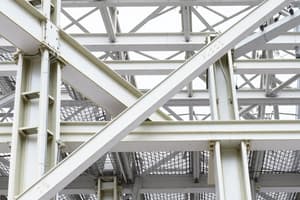Podcast
Questions and Answers
Which of the following correctly describes how the stress-strain relationship of a viscoelastic material is affected by the rate of loading?
Which of the following correctly describes how the stress-strain relationship of a viscoelastic material is affected by the rate of loading?
- Faster loading rates lead to higher stiffness and lower stress at a given strain.
- Faster loading rates lead to lower stiffness and lower stress at a given strain.
- Faster loading rates lead to lower stiffness and higher stress at a given strain.
- Faster loading rates lead to higher stiffness and higher stress at a given strain. (correct)
What is the effect of repeated loading cycles on the mechanical response of a viscoelastic material?
What is the effect of repeated loading cycles on the mechanical response of a viscoelastic material?
- The mechanical response remains unchanged regardless of the number of loading cycles.
- The mechanical response continuously improves with each additional loading cycle.
- The mechanical response continuously deteriorates with each additional loading cycle.
- The mechanical response shifts after the first few cycles, but remains stable with further cycling. (correct)
Which of the following best describes the relationship between stress and strain for a viscoelastic material during loading and unloading?
Which of the following best describes the relationship between stress and strain for a viscoelastic material during loading and unloading?
- The loading and unloading paths are identical, forming a straight line.
- The loading and unloading paths are different, forming a hysteresis loop. (correct)
- The loading path is a straight line, while the unloading path is curved.
- The loading and unloading paths are identical, forming a curved line.
How does the deformation of a viscoelastic material change over time under a constant applied load?
How does the deformation of a viscoelastic material change over time under a constant applied load?
What is the relationship between the initial length and the loaded length of a viscoelastic material over time?
What is the relationship between the initial length and the loaded length of a viscoelastic material over time?
How does the amount of energy recovered during unloading compare to the energy lost during loading for a viscoelastic material?
How does the amount of energy recovered during unloading compare to the energy lost during loading for a viscoelastic material?
Which of the following statements about stiffness (elastic modulus) is true?
Which of the following statements about stiffness (elastic modulus) is true?
In a three-point bending test, where is the failure most likely to occur?
In a three-point bending test, where is the failure most likely to occur?
Which of the following statements about the yield point is true?
Which of the following statements about the yield point is true?
In a cantilever bending situation, what is the primary cause of the bending?
In a cantilever bending situation, what is the primary cause of the bending?
Which of the following statements about extensibility is true?
Which of the following statements about extensibility is true?
In a bending situation, where are the maximum tensile and compressive stresses experienced?
In a bending situation, where are the maximum tensile and compressive stresses experienced?
Which of the following statements about torsion is correct?
Which of the following statements about torsion is correct?
What is the primary difference between brittleness and toughness in materials?
What is the primary difference between brittleness and toughness in materials?
Which of the following is NOT a unique characteristic of biological materials?
Which of the following is NOT a unique characteristic of biological materials?
What is the primary effect of increasing the strain rate on viscoelastic materials?
What is the primary effect of increasing the strain rate on viscoelastic materials?
What is the primary difference between a purely elastic material and a viscoelastic material?
What is the primary difference between a purely elastic material and a viscoelastic material?
Which of the following properties is NOT related to the fluid component in biological tissues?
Which of the following properties is NOT related to the fluid component in biological tissues?
When an object bends, where do the highest tensile and compressive stresses occur?
When an object bends, where do the highest tensile and compressive stresses occur?
What is the primary cause of bending in a cantilever bending situation?
What is the primary cause of bending in a cantilever bending situation?
Which of the following mechanical properties is related to an object's resistance to bending deformation?
Which of the following mechanical properties is related to an object's resistance to bending deformation?
In a bending scenario, where is the failure most likely to occur in a four-point bending test?
In a bending scenario, where is the failure most likely to occur in a four-point bending test?
Which of the following properties is NOT associated with torsion?
Which of the following properties is NOT associated with torsion?
What characteristic of a material describes its ability to undergo large deformations without rupture?
What characteristic of a material describes its ability to undergo large deformations without rupture?
Which of the following statements about stiffness (elastic modulus) is true?
Which of the following statements about stiffness (elastic modulus) is true?
What is the primary difference between a purely elastic material and a viscoelastic material?
What is the primary difference between a purely elastic material and a viscoelastic material?
Which of the following statements about extensibility is true?
Which of the following statements about extensibility is true?
Which of the following statements about torsion is correct?
Which of the following statements about torsion is correct?
What is the primary difference between brittleness and toughness in materials?
What is the primary difference between brittleness and toughness in materials?
Which of the following statements accurately describes the relationship between the radius of a shaft and its resistance to torsion?
Which of the following statements accurately describes the relationship between the radius of a shaft and its resistance to torsion?
In the context of material properties, what is the primary difference between brittleness and toughness?
In the context of material properties, what is the primary difference between brittleness and toughness?
How does an increase in strain rate affect the stiffness (elastic modulus) of a viscoelastic material?
How does an increase in strain rate affect the stiffness (elastic modulus) of a viscoelastic material?
Which of the following statements accurately describes the relationship between extensibility and plastic deformation in materials?
Which of the following statements accurately describes the relationship between extensibility and plastic deformation in materials?
In the context of viscoelastic materials, what is the primary difference between a purely elastic material and a viscoelastic material during loading and unloading?
In the context of viscoelastic materials, what is the primary difference between a purely elastic material and a viscoelastic material during loading and unloading?
Which of the following statements accurately describes the effect of torsion on a structure?
Which of the following statements accurately describes the effect of torsion on a structure?
Flashcards are hidden until you start studying




